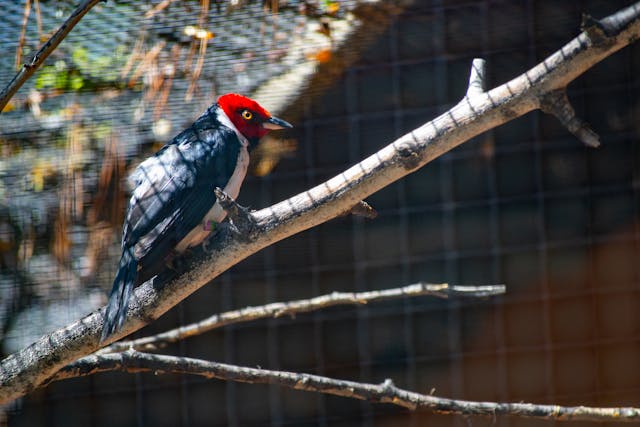Woodpeckers are fascinating birds known for their unique behaviour of pecking on trees with rapid, rhythmic beats.
While this drumming is essential to a woodpecker’s natural habits, many people wonder if it can harm or even kill the trees they frequent.
In this article, we’ll explore why woodpeckers peck at trees, whether they threaten tree health, and what can be done if their activity becomes a concern.
Why Do Woodpeckers Peck on Trees?
To understand the impact of woodpeckers on trees, it’s important first to know why they engage in this behaviour. Woodpeckers peck on trees for several key reasons:
Foraging for Food
One of the primary reasons woodpeckers drill into trees is to find food. They use their sharp beaks to search for insects, larvae, and other small creatures hidden beneath the bark.
Woodpeckers are particularly fond of wood-boring insects, such as beetle larvae and carpenter ants, which live inside the tree.
This feeding behaviour is actually beneficial for the tree, as it helps control pest populations that could otherwise cause severe damage.
Creating Nesting Cavities
Woodpeckers excavate holes in trees to create nesting sites for themselves and their offspring.
These cavities provide safe, sheltered environments for raising young. While these holes can appear large, they are usually restricted to a single area of the tree, and healthy trees can typically tolerate them without significant harm.
Communication and Territory Marking
Woodpeckers use drumming as a form of communication to establish territory and attract mates.

This drumming is often performed on dead or decaying trees, utility poles, or even house sidings and involves rapid, loud pecking that is more about making noise than causing damage.
Do Woodpeckers Actually Kill Trees?
The answer to whether woodpeckers kill trees is generally “no”—at least not directly. Woodpeckers typically target trees that are already weakened, diseased, or infested with insects.
Their activity is often a symptom of an underlying problem rather than the cause. However, there are certain situations where woodpeckers can contribute to a tree’s decline:
1. Trees Already Weakened by Disease or Pests
If a tree is already compromised by disease, fungi, or insect infestations, woodpecker activity can exacerbate the damage. Woodpeckers are drawn to weakened trees because they provide easier access to insects and larvae. While they help control pest populations, repeated pecking can further weaken the tree’s structure and create additional entry points for fungi and other pathogens.
2. Sapsuckers and Their Feeding Habits
A particular type of woodpecker, known as the sapsucker, can cause more noticeable damage. Sapsuckers drill horizontal rows of small holes in the bark of living trees to feed on sap.
While this feeding behaviour generally doesn’t kill healthy trees, it can cause stress and, in some cases, lead to bark injury or the entry of diseases. If sapsuckers repeatedly target a tree over many years, it may suffer from reduced vigor or become more susceptible to other issues.
3. Physical Damage to Young or Vulnerable Trees
Young trees with thin bark or already suffering from environmental stress may not withstand extensive woodpecker activity.
In such cases, repeated drilling can lead to significant damage that compromises the tree’s health or structural integrity, potentially leading to its decline over time.
How to Tell if a Tree is at Risk from Woodpeckers
To determine if a tree is at risk from woodpecker activity, look for the following signs:
- Large or Numerous Holes: A few holes on a tree may not cause concern, but extensive damage, especially on younger or weakened trees, can be problematic.
- Repeated Rows of Holes: If you notice horizontal or vertical rows of small holes, this could indicate sapsucker activity, which may need monitoring.
- Presence of Wood-Boring Insects: If you see signs of insect infestation, such as sawdust, frass, or exit holes, the woodpeckers are likely targeting the tree for food. In this case, addressing the insect issue may help reduce woodpecker activity.

What Can You Do If Woodpeckers Are Damaging Trees?
If you find that woodpeckers are causing significant damage to a tree, here are a few steps you can take:
- Provide an Alternative Food Source: Installing suet or bird feeders with nuts can attract woodpeckers away from trees.
- Protect Vulnerable Trees: Wrap burlap or mesh around areas of the tree being pecked to discourage woodpeckers. This is particularly useful for young trees or trees already weakened by other factors.
- Use Visual and Sound Deterrents: Hanging reflective tape, wind chimes, or other objects that move in the wind can help deter woodpeckers. Sound devices that play distress calls may also work, although their effectiveness can vary.
- Address Underlying Issues: If woodpeckers target a tree infested with insects, consider consulting an arborist to treat the tree for pests. Removing the food source may reduce woodpecker interest.
Conclusion: Woodpeckers and Tree Health – A Balanced Perspective
While woodpeckers are unlikely to kill healthy trees directly, their activity can contribute to the decline of trees already stressed or weakened by other factors.
Understanding the reasons behind their behaviour can help you determine whether intervention is needed and how to protect your trees without harming these beneficial birds. In most cases, woodpeckers play a valuable role in controlling pests and maintaining the health of forests and ecosystems.
By safeguarding vulnerable trees and providing alternative resources, you can create a balanced environment where woodpeckers and trees coexist peacefully, allowing nature to continue its intricate dance.
